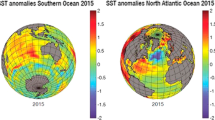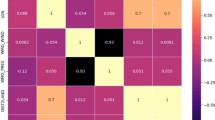Abstract
Sea surface temperature modifies the air in the earth’s atmosphere. \({\text{EINi}}\tilde{\eta }{\text{o}}\) signs in the sea surface temperature spread the warm water in the ocean and take the rain. Several existing models forecast rainfall using statistical analysis, machine learning, and deep learning. Neural Networks are powerful models that are extensively used for solving problems in many areas but still suffer from significant weaknesses. The presence of nonlinear hidden layers makes the deep networks prone to severe overfitting. This research used a rainfall dataset and reduced the issue of overfitting by using the improved regularized function. The main contribution of this research is proposing the enhanced regularized function to predict rainfall to reduce the bias. To evaluate the performance of the proposed Improved Regularization Function Long Short-Term Memory (IRF-LSTM) to forecast rainfall are RMSE, MAE, NSE, r. The output performance of the proposed IRF-LSTM is surpassed other state-of-the-art methods and is verified as by far the best implementation.













Similar content being viewed by others
Explore related subjects
Discover the latest articles, news and stories from top researchers in related subjects.Abbreviations
- IPCC:
-
Intergovernmental panel on climate change
- NECP:
-
National Centers for Environmental Prediction
- NWS:
-
National weather service
- SVR:
-
Support vector regression
- NOOA:
-
National oceanic and atmospheric administration
- RNN:
-
Recurrent neural networks
- SVM:
-
Support vector machine
- LSTM:
-
Long short-term memory
- CNN:
-
Convolution neural network
- MLP:
-
Multi-layer perceptron
- ANN:
-
Artificial neural network
- APSDPS:
-
Andhra Pradesh State Development Planning Society
- GRU:
-
Gated recurrent unit
- RMSE:
-
Root mean square error
- MAE:
-
Mean absolute error
- NSE:
-
Nash Sutcliffe model efficiency
References
Deser C, Alexander MA, Xie SP, Phillips AS (2010) Sea surface temperature variability: patterns and mechanisms. Annu Rev Mar Sci 2:115–143
Wentz FJ, Schabel M (2000) Precise climate monitoring using complementary satellite data sets. Nature 403(6768):414–416
Trenberth KE, Shea DJ (2005) Relationships between precipitation and surface temperature. Geophys Res Letters 32(14):5646. https://doi.org/10.1029/2005GL022760
Roxy M (2014) Sensitivity of precipitation to sea surface temperature over the tropical summer monsoon region—and its quantification. Clim Dyn 43(5–6):1159–1169
Cardona OD, Van Aalst MK, Birkmann J, Fordham M, Mc Gregor G, Rosa P, Pulwarty RS, Schipper EL, Sinh BT, Décamps H, Keim M et al (2012) Determinants of risk: exposure and vulnerability. Managing the risks of extreme events and disasters to advance climate change adaptation: special report of the intergovernmental panel on climate change. Cambridge University Press, UK, pp 65–108
Vaes G, Willems P, Berlamont J (2001) Rainfall input requirements for hydrological calculations. Urban Water 3(1–2):107–112
Bui DT, Tsangaratos P, Ngo PT, Pham TD, Pham BT (2019) Flash flood susceptibility modeling using an optimized fuzzy rule based feature selection technique and tree based ensemble methods. Sci Total Environ 668:1038–1054
Deo RC, Salcedo-Sanz S, Carro-Calvo L, Saavedra-Moreno B (2018) Drought prediction with standardized precipitation and evapotranspiration index and support vector regression models. Integrating disaster science and management. Elsevier, UK, pp 151–174
Abedini M, Ghasemian B, Shirzadi A, Shahabi H, Chapi K, Pham BT, Bin Ahmad B, Tien BD (2019) A novel hybrid approach of bayesian logistic regression and its ensembles for landslide susceptibility assessment. Geocarto Int 34(13):1427–1457
Bezak N, Sraj M, Mikoˇs M (2016) Copula-based idf curves and ˇ empirical rainfall thresholds for flash floods and rainfall-induced landslides. J Hydrol 541:272–284
Abbot J, Marohasy J (2017) Skilful rainfall forecasts from artificial neural networks with long duration series and single-month optimization. Atmos Res 197:289–299
Zellou B, Rahali H (2019) Assessment of the joint impact of extreme rainfall and storm surge on the risk of flooding in a coastal area. J Hydrol 569:647–665
Zhang P, Zhang L, Leung H, Wang J. (2017) A deep learning based precipitation forecasting approach using multiple environmental factors. In: 2017 IEEE international congress on big data (BigData Congress), IEEE, pp: 193–200
Caihong Hu, Qiang Wu, Li H, Jian S, Li N, Lou Z (2018) Deep learning with a long short-term memory networks approach for rainfall-runoff simulation. Water 10(11):1543
Haidar A, Verma B (2018) Monthly rainfall forecasting using one dimensional deep convolutional neural network. IEEE Access 6:69053–69063
Charaniya NA, Dudul SV (2013) Design of neural network models for daily rainfall prediction. Int J Comput Appl 61(14):23–27
Puah YJ, Huang YF, Chua KC, Lee TS (2016) River catchment rainfall series analysis using additive holt–winters method. J Earth Syst Sci 125(2):269–283
Gope S, Sarkar S, Mitra P, Ghosh S. (2016) Early prediction of extreme rainfall events: a deep learning approach. In: Industrial conference on data mining, Springer, pp: 154–167.
Dubey AD (2015) Artificial neural network models for rainfall prediction in pondicherry. Int J Comput Appl 120(3):30–35
Ashby SA, Taylor MA, Chen AA (2005) Statistical models for predicting rainfall in the caribbean. Theor Appl Climatol 82(1):65–80
Partal T, Cigizoglu HK, Kahya E (2015) Daily precipitation predictions using three different wavelet neural network algorithms by meteorological data. Stoch Environ Res Risk Assess 29(5):1317–1329
Khan MI, Maity R (2020) Hybrid deep learning approach for multi-step-ahead daily rainfall prediction using gcm simulations. IEEE Access 8:52774–52784
Zhang P, Cao W, Li W (2021) Surface and high-altitude combined rainfall forecasting using convolutional neural network. Peer-toPeer Networking and Applications 14(3):1765–1777
Hernández E, Sanchez-Anguix V, Julian V, Palanca J, Duque N (2016) Rainfall prediction: a deep learning approach. In: International conference on hybrid artificial intelligence systems, Springer, pp 151–162
Ghiasi G, Lin TY, Le QV. (2018) Dropblock: A regularization method for convolutional networks. arXiv preprint arXiv:1810.12890
Yamada Y, Iwamura M, Akiba T, Kise K (2019) Shakedrop regularization for deep residual learning. IEEE Access 7:186126–186136
Gastaldi X. (2017) Shake-shake regularization. arXiv preprint arXiv:1705.07485
Srivastava N, Hinton G, Krizhevsky A, Sutskever I, Salakhutdinov R (2014) Dropout: a simple way to prevent neural networks from overfitting. J Mach Learn Res 15(1):1929–1958
Haibing Wu, Xiaodong Gu (2015) Towards dropout training for convolutional neural networks. Neural Netw 71:1–10
Park S, Kwak N. (2016) Analysis on the dropout effect in convolutional neural networks. In: Asian conference on computer vision, Springer, pp 189–204
DeVries T, Taylor GW (2017) Improved regularization of convolutional neural networks with cutout. arXiv preprint arXiv:1708.04552
Ba J, Frey B (2013) Adaptive dropout for training deep neural networks. Adv Neural Inf Process Syst 26:3084–3092
Bulò SR, Porzi L, Kontschieder P (2016) Dropout distillation. In: International conference on machine learning, PMLR, pp 99–107
Li Z, Gong B, Yang T (2016) Improved dropout for shallow and deep learning. Adv Neural Inf Process Syst 29:2523–2531
Gong C, Ren T, Ye M, Liu Q (2020) Maxup: A simple way to improve generalization of neural network training. arXiv preprint arXiv:2002.09024
Usharani B (2022) ILF-LSTM: Enhanced loss function in LSTM to predict the sea surface temperature. Soft Comput 15:1433–7479. https://doi.org/10.1007/s00500-022-06899-y
Andhra Pradesh State Development Planning Society http://www.apsdps.ap.gov.in/; online accessed 20–05–2021
Intergovernmental panel on climate change ; https://www.ipcc.ch/; online accessed 20–05–2021
Wu CL, Chau KW, Fan C (2010) Prediction of rainfall time series using modular artificial neural networks coupled with data-pre-processing techniques. J Hydrol 389(1–2):146–167
Dabhi VK, Chaudhary S (2014) Hybrid wavelet-postfix-Gp model for rainfall prediction of Anand region of India. Adv Artif Intell 2014:1–11
Sehad M, Lazri M, Ameur S (2017) Novel SVM-based technique to improve rainfall estimation over the Mediterranean region (north of algeria) using the multispectral msg seviri imagery. Adv Space Res 59(5):1381–1394
Jing J, Li Q, Peng X (2019) Mlc-lstm: exploiting the spatiotemporal correlation between multi-level weather radar echoes for echo sequence extrapolation. Sensors 19(18):3988
Sun D, Wu J, Huang H, Wang R, Liang F, Xinhua H (2021) Prediction of short time rainfall based on deep learning. Math Problems Eng 1–8:2021
Author information
Authors and Affiliations
Corresponding author
Ethics declarations
Conflict of interest
The author(s) declared no potential conflicts of interest with respect to the research, authorship, and/or publication of this article.
Additional information
Publisher's Note
Springer Nature remains neutral with regard to jurisdictional claims in published maps and institutional affiliations.
Rights and permissions
About this article
Cite this article
Bhimavarapu, U. IRF-LSTM: enhanced regularization function in LSTM to predict the rainfall. Neural Comput & Applic 34, 20165–20177 (2022). https://doi.org/10.1007/s00521-022-07577-8
Received:
Accepted:
Published:
Issue Date:
DOI: https://doi.org/10.1007/s00521-022-07577-8




